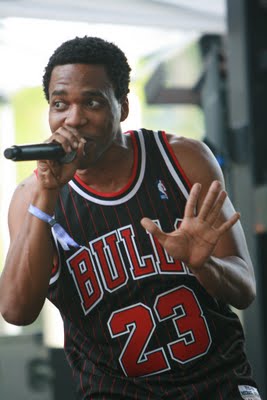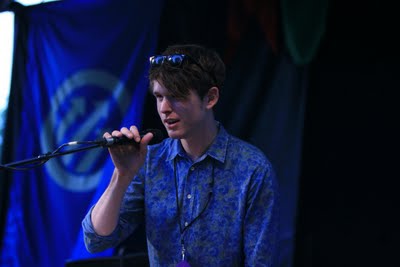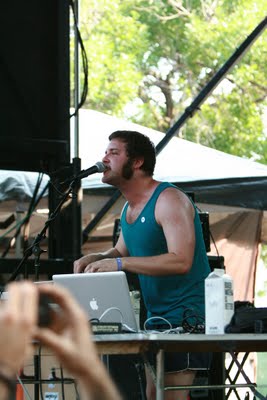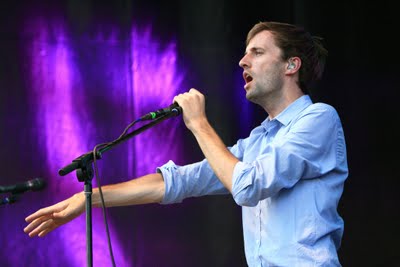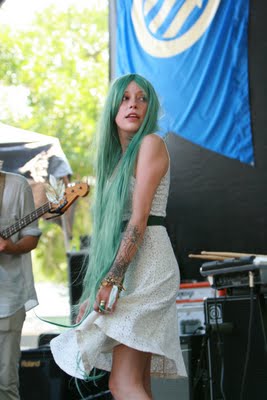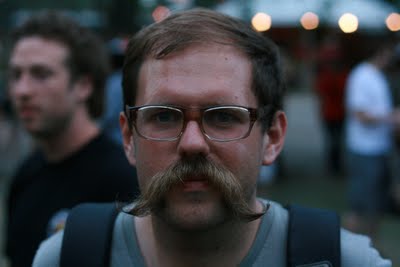by Raj Ranade
 A scorching Midwest heat wave didn’t stop nearly 45,000 eager fans from spending a weekend out in the Union Park sun for Chicago’s Pitchfork Music Festival. Writer Raj Ranade and photographer Willie Miller braved Axe-deodorant-wielding corporate sponsors and drunken hipsters to take in three days of sets from some of the most interesting bands in the country. Here’s a recap of the festival’s highlights – full photo coverage of the festival is available here. More photos of all acts will be posted shortly.
A scorching Midwest heat wave didn’t stop nearly 45,000 eager fans from spending a weekend out in the Union Park sun for Chicago’s Pitchfork Music Festival. Writer Raj Ranade and photographer Willie Miller braved Axe-deodorant-wielding corporate sponsors and drunken hipsters to take in three days of sets from some of the most interesting bands in the country. Here’s a recap of the festival’s highlights – full photo coverage of the festival is available here. More photos of all acts will be posted shortly.
Gatekeeper, Friday, 3:20 PM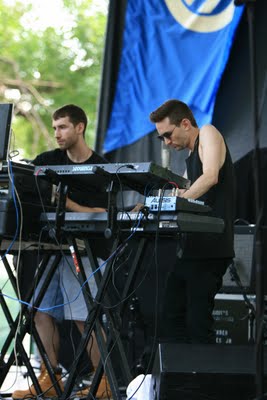
Chicago-based electronic-music duo Gatekeeper started off the festival with what mostly seemed like a tribute to the Terminator movie series. This is not just because Gatekeeper makes brooding dance music out of 80s sci-fi film-score synthesizers and arpeggiators, but because the wiry Aaron David Ross, wearing circle-rimmed glasses and black tanktop, was doing a pretty excellent Sarah-Connor-in-Terminator-2 imitation up on stage. The band’s set inspired minor amounts of audience grooving, but it was a pretty awkward fit with the blistering Friday afternoon sun – this is music to soundtrack motorcycle rides through Tokyo /post-apocalyptic assassination attempts on L.A. androids.
tUnE-yArDs, Friday, 4:30 PM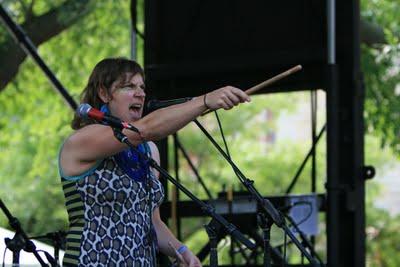
Every superficial indicator about tUnE-yArDs seems to embody the kind of preciousness that can be unbearable in indie pop – that cutesy/irritating capitalization scheme, the fact that the ukelele is a key element of the music, the fact that she took the stage wearing face-paint. But all is forgiven when multi-instrumentalist Merrill Garbus unleashes her voice on a crowd, a brassy, muscular wail that commands attention. And the voice is only part of the package – Garbus employs a loop pedal so that she can be her own percussionist and rhythm section, leaving only the saxophone-playing to her bandmates. tUnE-yArDs play unpredictable and irresistable pop songs that defy categorization, pitting R&B and baroque pop against flashes of punk distortion and energy. It’s a mix that drew an ecstatic response – Garbus wasn’t kidding when she giddily exclaimed “You guys are a massive bundle of love”.
New Orleans rapper Curren$y turned in one of the most crowd-pleasing sets of Friday, not that he necessarily cared what the crowd thought of him – the man was clearly having too much fun to really worry about that. Bounding around the stage in a Chicago Bulls jersey, Curren$y delivered blistering verses alongside banter about crowd validation (“Y’all don’t need to clap after every song – I know you love this ****”), the drug that is the focus of much of his work (“Light ’em up if you got ’em! But you young ones, just say no – no matter how cool it looks”), and the inexplicable outbreak of crowd-surfing during a rap show (“Look at that guy!”). A DJ played breezy beats to accompany some of the lyricism, but more often than not, the young rapper went acappella – this was a man in love with the sound of his own voice in one of the few contexts where that’s a good thing.
British electronic musician James Blake makes two kinds of music – pounding dance music that draws from R&B and the aggressive sound of dubstep, and minimalist, tender ballads that showcase a soulful, quavering voice. Blake began his set playing the latter, which was haunting and beautiful and also often drowned out by the country-folk belting of Neko Case on the other side of the park. Blake, a gangly presence with a vulnerable look that makes him seem younger than his 21 years, played off the sound bleed with good humor (“This has become a sort of duet, I guess”), but the set didn’t really take off until Blake unleashed the dancefloor big guns. Suddenly, the already loud bass drums exploded into walls of sound that forced anyone who wasn’t already dancing to at least vibrate – a confident reclamation of the evening from the frail kid at the keyboards.
Chrissy Murderbot feat MC Zulu, Saturday, 1:00 PM (INTERVIEW) Chrissy Murderbot’s blog My Year of Mixtapes is a serious work of music scholarship – Murderbot posts free downloadable mixtapes that detail entire eras and subgenres of dance music along with thoughtful commentary about the social contexts and history that inspired those musical movements. But the goal of the Chicago DJ’s own music is a little different. “I’ve always been interested in the overlap between the culture and history of a place and the music that comes from there [but] if you forget that your job as a DJ is stupid party music, then the music is not going to be fun,” said Chrissy. “Of course, I try to make thoughtful, artistic stupid party music, but the stupid party music takes precedence.”
Thoughtful, artistic stupid party music was indeed Murderbot’s Saturday set in a nutshell – the party was awash in the sound of the lip-shaped plastic whistles Murderbot’s minions handed out and the beats were backed by bawdy vocal samples that would make even the filthiest beat-makers blush, but Murderbot and fellow Chicagoan MC Zulu had a skillful control over the audience they were whipping into a frenzy. Murderbot’s music fuses worldwide dance genres like juke, footwork, and dubstep into concentrated party-starters, while Zulu, megaphone in hand, exhorts the audience into dancing. It’s a potent combination – one that Murderbot tailors specifically to each context. “At a club, people are there to dance, but here at a festival, people are here to chill and watch bands. That’s why [Zulu and I] make so much sense on stage – we have an interaction that’s something for people to watch, but they can also dance and get the real club experience if they want to.”
That interaction benefits greatly from Zulu’s many years in the music business – Zulu started out as a producer and ghost-writer for other artists (“I keep getting work getting work because I don’t name names,” he said when pushed for examples) in the early 90s before striking out on his own as a dancehall vocalist. Influenced heavily by reggae artists like Buju Banton and Bounty Killer, Zulu has spent years developing a signature style in a genre where even the best artists can blur together for non-experts. “If a casual fan can’t tell the difference between me and another artist, I might be doing it right but I need to do it better,” said Zulu. From Saturday’s set, improvement barely seems necessary, as Zulu’s baritone held in the audience in thrall. With Murderbot’s help, Zulu cemented Chicago’s reputation as one of the world capitals for innovative new club bangers.
G-Side, Saturday, 2:50 PM (INTERVIEW)
The narrative of Huntsville, Alabama rap duo G-Side’s hip-hop-aided escape from crime and poverty may be familiar, but their sound is not. G-Side make songs with a cosmic vibe far removed from the typical street-level earthiness of most rap – their reverb-laden productions pair hard-hitting hip-hop drums with psychedelic synthesizers and oddball samples from indie rockers like Beach House. “We’re always looking for something that nobody’s ever heard – a fresh new feeling,” says David “Yung Clova” Williams. “[Our producers] CP and Mali are always in a trance doing their beats,” adds Stephen “ST 2 Lettaz” Harris, referring to their innovative production team The Block Beattaz. “That’s where that unique slow motion sound comes from.”
The spaciness of the sound comes paired with lyrics about far more practical concerns. Specifically, G-Side spends a lot of type rapping about the business of G-Side – the group has fashioned an unconventional route to stardom by avoiding label deals and crafting their fanbase online, and their songs sometimes feel like a manual to hip-hop stardom in the internet age. Part of that strategy involved going after foreign stardom as eagerly as they pursued domestic fame. “I call it the Reverse Beatles Theory,” says Harris. “Europeans are into that Down South [music] because it’s foreign, so it latches on and blows up faster over there. Then back home they see that European hype and it blows up over here!” The music entertainingly details the foibles involved in a local group crossing borders – on “How Far”, Lettaz raps “Waiting for my passport at the last minute/Next week is my first show in Toronto/And if it don’t come then I don’t go/But I guess you could say that’s one of them good problems/That’s a long way away from my hood problems.”
For all of their innovation, though, the group puts on a solidly satisfying old-fashioned rap show. Harris bounds around and off the stage while rapping, diving into the front of the crowd to deliver a few verses, while Williams is the controlled counterpart to his exuberant partner, holding the fort on stage and leading the audience in old-school call-and-response chants. There’s a palpable hunger to the performance, which has put G-Side at the front of Huntsville’s disproportionately large and talented rap scene, which includes groups like Paper Route Gangstaz, Yelawolf, and Jackie Chain. “There must be something in the water, or it might be the rockets,” says Harris, referring to Huntsville’s NASA facilities. “You’ve only heard about 30 percent of what Huntsville has to offer”. If that remaining 70% is anything like G-Side, let’s hope they Reverse Beatles their way to fame soon.
OFF!, Saturday, 4:45 PM
The set by hardcore punk supergroup OFF! managed the improbable feat of simultaneously one of the festival’s most aggressive shows and one of its crankiest. OFF! songs are two-minute emotion dumps of angst and rage, instant mosh-pit starting guitar maelstroms with titles like “I Don’t Belong”. OFF! stage banter, on the other hand, consisted of lead singer Keith Morris, with a surprisingly menacing combination of dreadlocks and a combover, lecturing the audience on punk bands of the past and shaking his fist at, among others, people who text while driving and people who carry too many items to the 10-items-or-less checkout line. Nevertheless, the band certainly succeeded in, as Morris put it, bringing “a different flavor to the party”, injecting a bit of cathartic rage into a festival dominated by relatively laid-back acts.
Twin Shadow, Saturday, 6:45 PM
Mellow rockers Twin Shadow are going to be embarking on the “Clean Cuts Tour” in September, where lead singer George Lewis Jr. will be molding his famously malleable hair into a different hairstyle for each city. So it was a bit of a disappointment to see him wearing a hair-concealing African kufi for his Pitchfork appearance (stylish though it was), but the music luckily made up for it. Lewis was restrained and professional on stage, which made the heart-on-denim-jacketed-sleeve tunes he sang in a Morrissey-esque tenor even more moving. The clipped stage manner did crack once though – Lewis couldn’t help expressing wonder at the fact that he was playing across the park from The Dismemberment Plan, his “favorite band when I was 18 years old.”
Shabazz Palaces, Sunday, 3:45 PM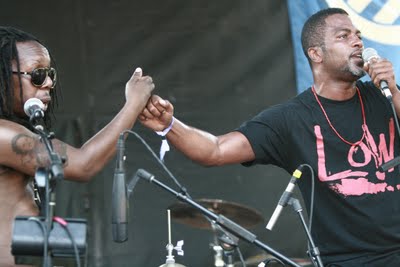
The most buzzed-about rap act at the festival was LA shock-rap collective Odd Future, whose blog-baiting misogyny-packed lyrics and unhinged stage antics obscure the fact that the actual music they produce is a slog to listen to. Rap group Shabazz Palaces, on the other hand, shun press hype, hold the stage with the dignified manner of elder rap statesmen (central rapper Ishmael Butler was a member of the hit 90s group Digable Planets), and have made one of the finest albums of the new year. It’s unfortunate that Pitchfork chose to schedule the acts against each other, but the relatively sparse Shabazz crowd was in for one of the festival’s finest performances. Butler raps about the pitfalls of gangsta-rap materialism and the power of enlightened hip-hop over beats that clank and buzz, and the combination is even more impressive live – not only does Butler have the fiery conviction of a great orator, he’s also the rare rapper who manages his music live himself instead of relying on a DJ (a dreadlocked compatriot was present to contribute bongo-playing and thumb-piano solos). The set was so enthralling that when the band broke into synchronized dance moves mid-set, the effect was less comedic than it was powerful – black musicians repurposing what could be Motown swing moves into a political/mystical/spiritual rallying cry for a new era.
It was apparent early on that 22-year-old Will Wiesenfeld, who plays largely instrumental hip-hop under the moniker Baths, was not exactly an experienced festival performer: he had to stop the set briefly to ask for a towel, he loudly called attention to a mistake he made while performing that few audience members likely would have noticed, he seemed giddy about the audience recognizing his songs but also seemed to chide them for dancing hard to a song that he thought was a “chiller”. None of this, however, really mattered, because of Wiesenfeld’s sheer energy – Wiesenfeld’s entire torso jerked up and down in time with the stuttering beats pumping out of his equipment, inspiring similar behavior from the amped-up crowd. Things got weird when the young performer played a spacey, melodically challenged new song, but for most of the set Wiesenfeld expressed more irresistible energy through a portly frame than any Pitchfork performer since Dan Deacon.
Cut Copy’s “another day at the office” stage attire of classy button-downs and dress pants doesn’t scream “festival’s biggest dance party”, but the fact that the band members had sweated through their shirts completely by the second song said otherwise. This Austrialian synth-pop band makes unabashedly cheesy music that owes quite a bit to New Order and Depeche Mode (lead singer Dan Whitford was maybe a bit too in love with the outstretched-arms-sweeping-towards-the-sky dance moves of stadium rock, and bassist Ben Browning’s decision at one point to jump on the band’s drum set and smack the cymbals with a tambourine was more baffling than awe-inspiring) but it’s hard to imagine a better environment for this kind of music. It’s hard, after all, to feel self-conscious about full-on nostalgia for thumping 80s dance-pop when thousands of like-minded fans are losing their minds to the music behind you.
HEALTH, Sunday, 7:40 PM
HEALTH spared about half a breath for an intro (“Hiwe’reHEALTHwe’refromlosangeles”) before the speakers erupted into a haze of screaming guitars, industrial clanking, and growling synthesizers. This kind of music is an acquired taste, to put it mildly, but even audience members who resist the glorious future-punk distortion of the music had plenty to see in the band’s controlled explosion of a performance. The chief highlight was bassist/electronic noise wrangler John Famiglietti, who looked like the love child of Sid Vicious and a particularly disheveled mop. Famiglietti careened back and forth across the stage, whipping his chest-length hair around so furiously that it seemed a churning dust cloud sat atop his shoulders. Mosh pits were, of course, inevitable and appropriate, as this next-to-last set of the festival may well have been the festival’s most pulverizing.
More Photos:


